Plumeria spp.
If you’re curious about what kind of effort it takes to grow plumeria, you’ve come to the right place.
Who wouldn’t want this gorgeous specimen in their landscape? Also called frangipani, it’s worth the effort to bring its bright, stunning blooms and interesting structure home, but you may be thrilled to learn that the work required is minimal.

We link to vendors to help you find relevant products. If you buy from one of our links, we may earn a commission.
We’ll cover all the details about this shrub or small tree – including cultivars to choose for container growing so they can grace your garden with flowers that add a lingering aroma and stunning beauty, no matter where you live.
Without further ado, let’s talk about planting, growing, and caring for plumeria!
Here’s what to expect:
What You’ll Learn
What Is Plumeria?
Plumeria is a genus belonging to the Apocynaceae family, also known as the dogbanes. They’re closely related to milkweeds and oleanders, and often referred to by the common names frangipani, dok champa or champa, and melia.
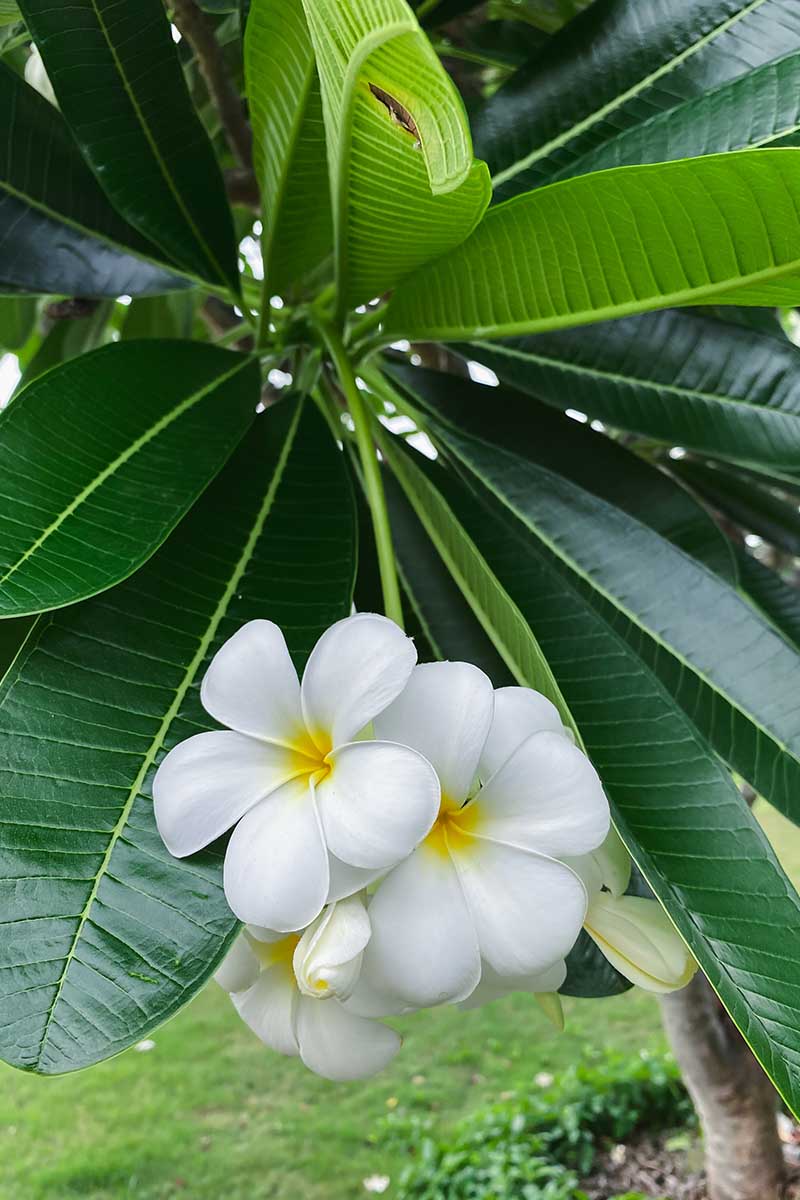
Currently, there are 11 accepted species in the genus, although there are others that are under debate, with hundreds of additional known cultivars and hybrids.
Species of this genus are native to Central America and the West Indies where they grow in forests as understory trees.
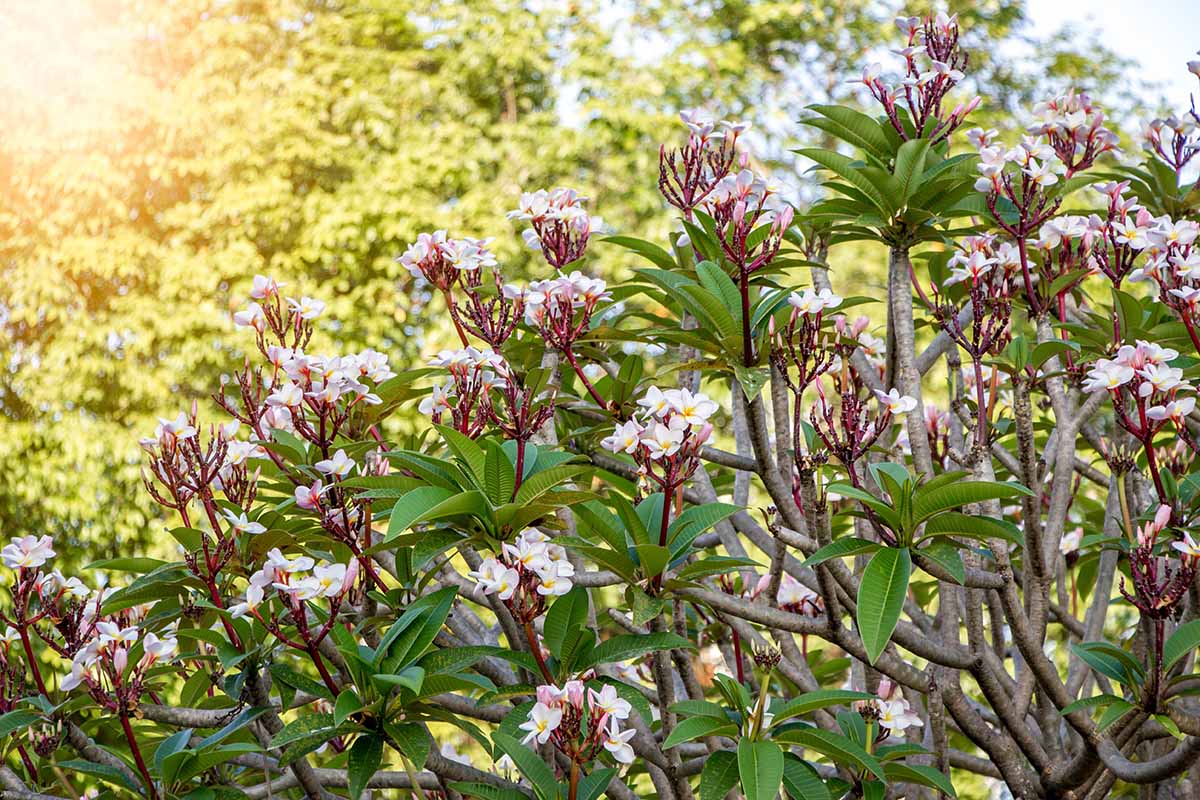
Because of their relatively compact size, large leaves, and showy bloom clusters, they’ve become staple landscaping plants throughout southern Florida, Texas, California, and the Hawaiian Islands, as well as many other parts of the world.
Their blossoms are often recognized as a symbol of the tropics. And there is some confusion about where these plants originated, as many erroneously believe they hail from Hawaii due to the historical use of frangipani blossoms to make leis.
Frangipani is not found in the wild in Hawaii, but there are several breeding programs there that are still producing new cultivars.
Anatomy
Most common species produce slightly overlapping, pinwheel-shaped, waxy flowers in tones of white, yellow, pink, orange, apricot, red, and magenta. Petals may be rounded or pointed, fluting from tubes that sometimes appear in contrasting colors.
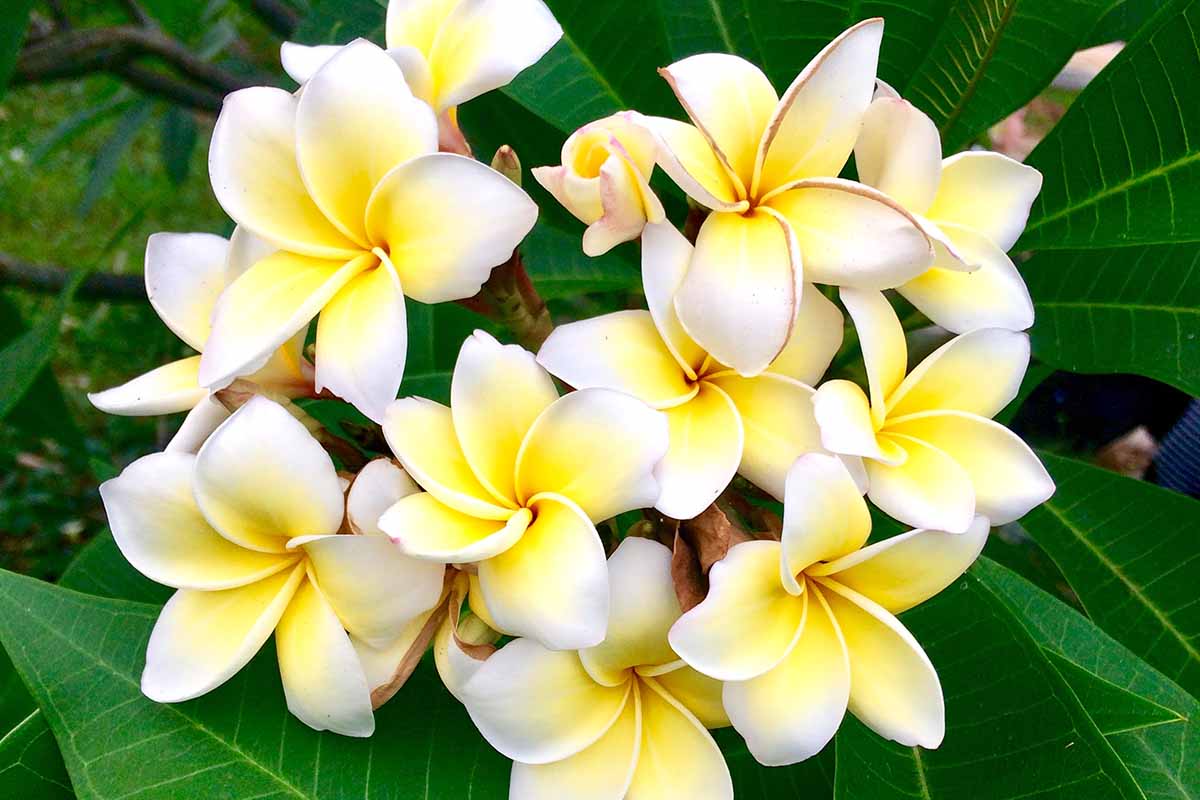
Some cultivars produce shell-type blossoms. These have petals that are folded together more tightly than the open types and they sometimes have contrasting striping or bands, such as in the cultivar known as ‘Madras White Shell.’
Some less common species, such as P. stenopetala, produce blooms that have thin, long petals radiating from a central tube. Their leaves also tend to be more narrow and they don’t root well from cuttings, so they’re harder to find for sale.
In subtropical regions, such as USDA Plant Hardiness Zones 9 to 11, buds begin to appear in March and April that will open through October or November.
Blossoms are typically two to three inches in diameter, and sometimes have contrasting centers – such as the white blooms with yellow centers of P. alba, which is one of the most easily recognized species.
There are some tones, however, that are less common, such as a deep magenta that appears purple, and a deep red that is sometimes referred to as black, such as in P. rubra ‘Scott Pratt Volcano’ or ‘Kohalo.’ This species produces deep red blooms that can darken to appear nearly black in high temperatures.
Their fragrance is stronger in the evening to attract nocturnal pollinators. But there’s a catch.
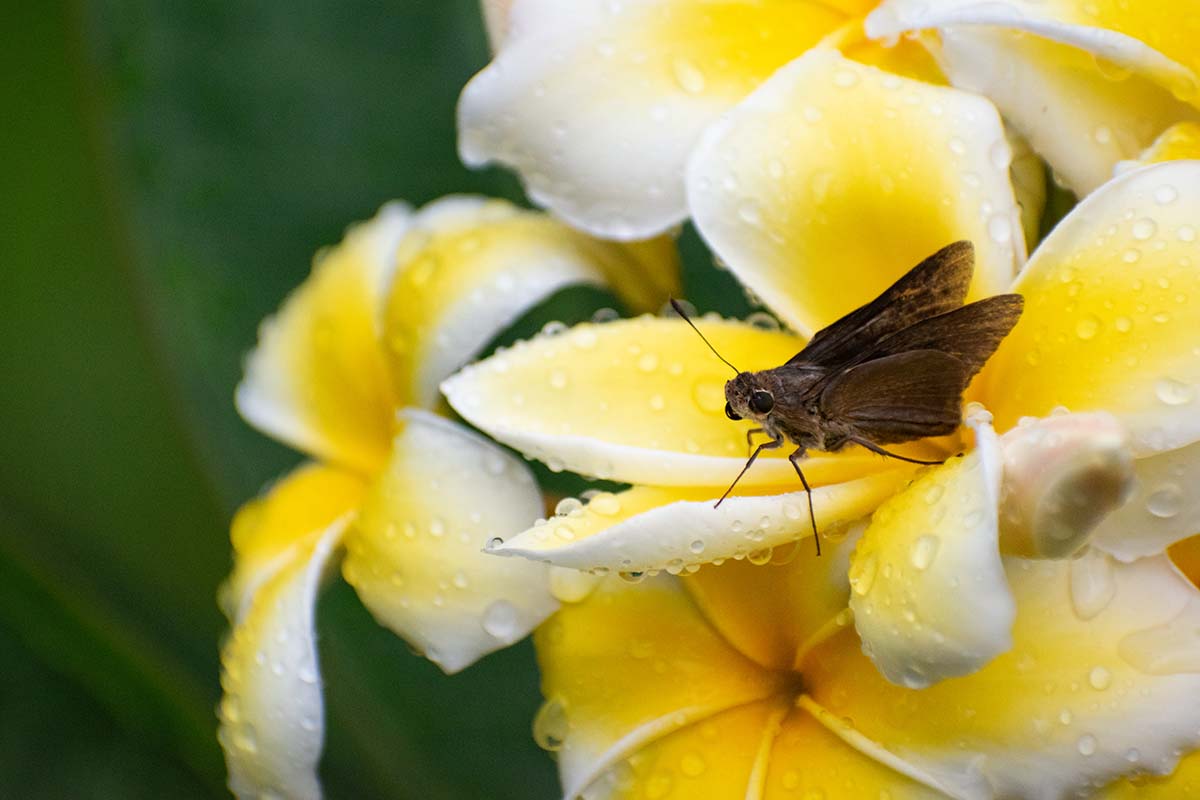
Plumeria are tricksters. They may be beautiful, but to pollinators, it’s a cruel beauty. The strong fragrance produced by the blooms lures in bees, butterflies, and moths, such as sphinx and hawkmoths, for a taste of nectar – only to find there is no nectar to be had.
Instead, the moths shake pollen free from the self-pollinating blooms where it falls to exposed stamens on the blossoms below, thus pollinating the plant with no return for the moth.
Thrips and ants are also known to pollinate the flowers as they crawl into the exposed tubes of the carpels.
Pollinated flowers of some specimens produce horn-shaped seed pods in shades of green, brown, rust, or black. The seeds inside are coated in a papery filament and easily spread by the wind when the pods mature and crack open.
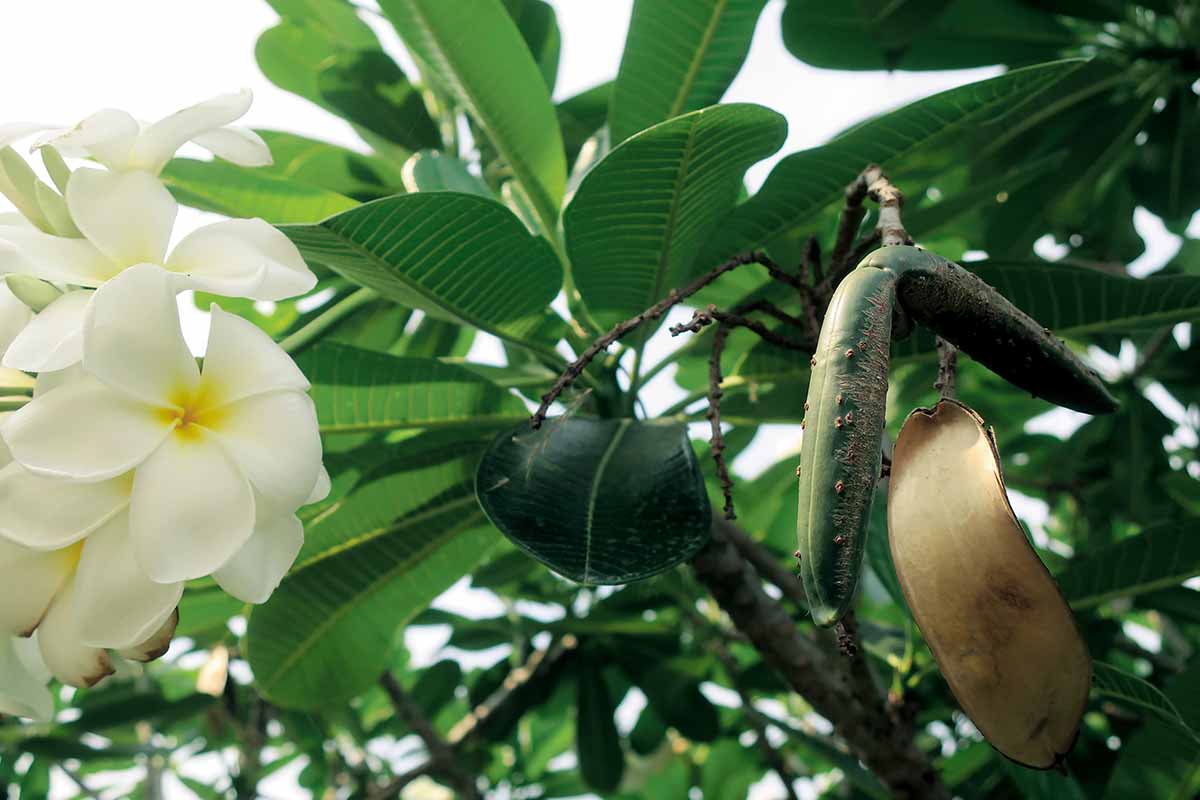
Blossoms are terminal, appearing at the ends of the bare branches that look sparse and spindly without foliage. The trees form multiple trunks that support a lushly scented, dense, umbrella- shaped canopy of foliage and blooms.
With pruning, plants can be kept to a shrub shape, or smaller landscape feature. They can also be maintained in a smaller size for growing in containers and moved indoors if your region has chilly winters.
There are dwarf cultivars available as well, such as P. obtusa ‘Dwarf Singapore Pink,’ which rarely reach heights of more than 10 feet.
Non-dwarf types are fast-growing and can reach heights of 20 feet or more in ideal conditions. But in landscaping specimens, heights of more than 15 feet are unusual.
Let’s take a brief look at how this genus came to be so widely beloved.
Cultivation and History
In the mid-1700s, Carl Linnaeus named the genus after Charles Plumier, one of the most renowned French botanists of the 18th century. Plumier had traveled to the Caribbean numerous times, documenting hundreds of species, including several plumeria.
In their native region, both Mayan and Aztec peoples believed them to be a symbol of life and fertility. They included plantings in the gardens of nobles and surrounded their temples with them.
While frangipani is endemic to Central America, it has been exported all over the world to regions with tropical climates such as Hawaii, Thailand, and Laos, where it has been incorporated into local cultural practices in many instances.
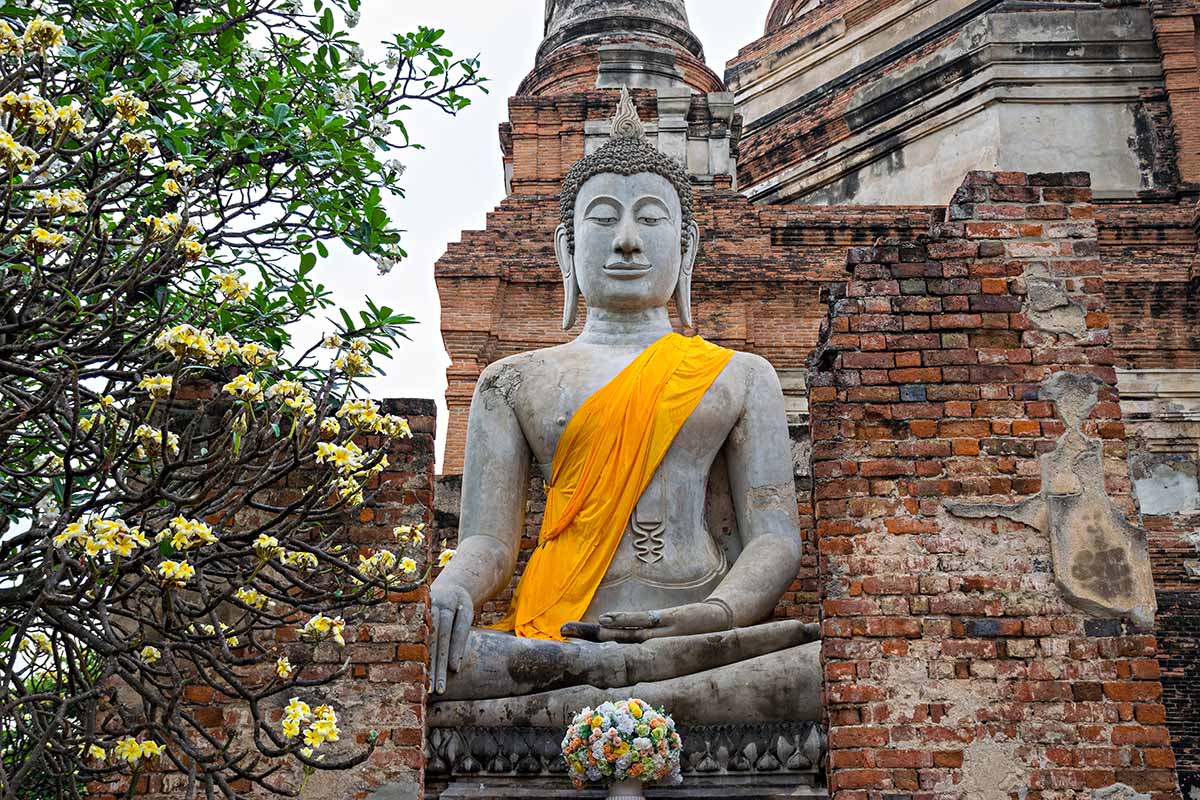
It’s so beloved in Laos and Nicaragua, in fact, that it has been named as the national flower in both countries. In Hawaii, it’s used to make leis, which are a symbol of peace, love, friendship, and welcoming.
Early Polynesians and indigenous Hawaiians created leis made from a wide variety of materials such as nuts, flowers, seashells, bone, and teeth, and wore them as adornments or presented them to others.
Today, plumeria is still added to leis to symbolize new beginnings.

Frangipani oil has been used in fragrances for centuries, lending a distinctively sweet, fruity note that conjures images of sipping a drink out of a coconut on a sunny beach. Some varieties, such as ‘San Germain,’ have a heady, intense fragrance.
If you’ve heard of nag champa, you may know that it’s comprised of sandalwood and frangipani (P. rubra), and is one of the most popular perfumes in India and surrounding regions. It’s frequently used to scent incense.
Because of its close relationship to oleander, which is highly toxic, you might guess that plumeria shares that characteristic.
The sap plumeria exudes can sometimes cause mild irritation and most parts of the plant are toxic if ingested, but the blooms are regarded as edible.
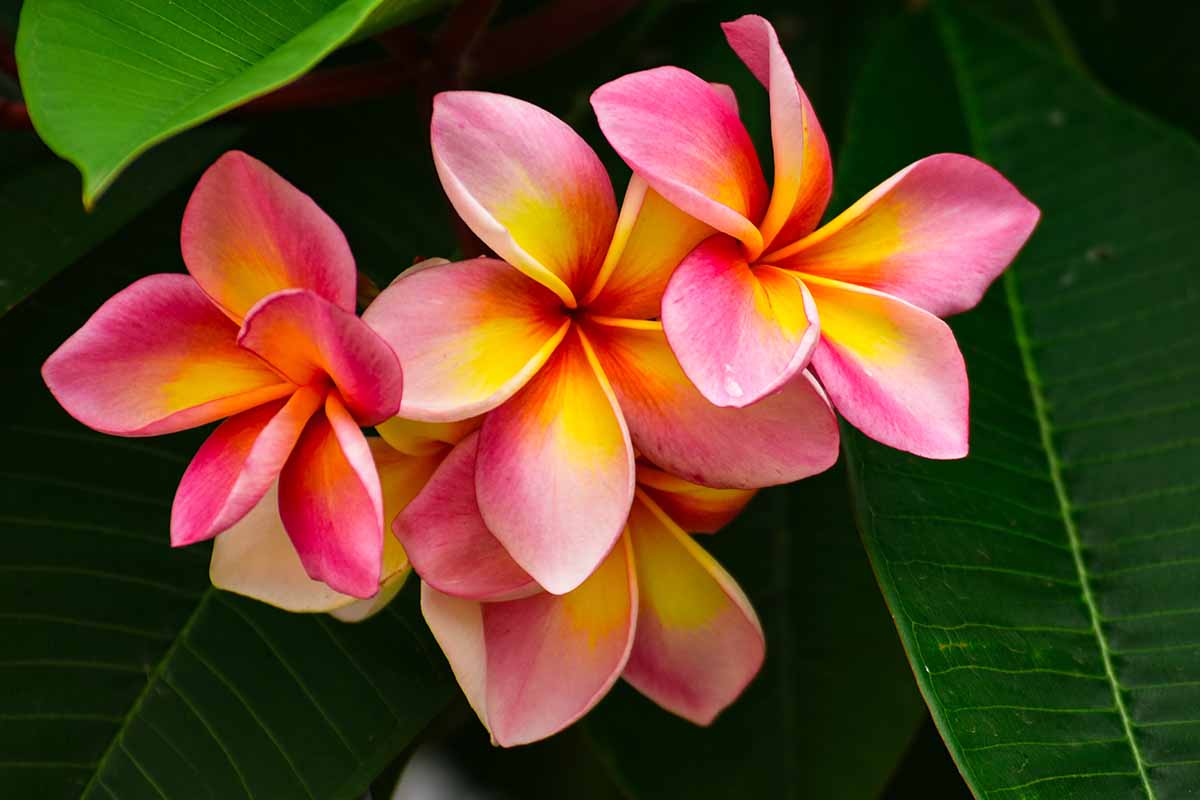
Their sweet taste is often compared to honey, but it’s important to note that consuming too many blooms can cause stomach upset and is not recommended.
Not every variety of plumeria will produce seed – some never do, and must be propagated by rooting cuttings instead. Seed pods take between nine months and a year to split open, and the seeds inside can develop mildew or rot if they’re not extracted quickly.
Even if you have a specimen that has produced seed, the resulting appearance of plants that germinate is left completely up to chance, as they do not grow true to the parent. Experimenting with seeds can still be fun and may lead to the development of exciting new cultivars!

Red, yellow, and white specimens tend to produce seedlings with flowers of the same color, although they may exhibit significant differences otherwise.
Pink and multicolored specimens rarely produce the same colors and are often completely different from the parents.
Whether you’re willing to take your chances to see what secret those little seeds hold, or you would rather start with cuttings for a predictable result, we’ll give you some tips on propagation next.
Propagation
Propagation is easy, whether from seed or by taking cuttings.
As I mentioned, rooting cuttings is the most reliable way to produce a clone of the parent. Cuttings also produce blossoms much faster than seed, so if you’re short on time and don’t want to wait, or you’re cloning a specimen, this is the better option.
One method of seed collection is known as passive harvesting. In this method, a barrier is used to prevent the seeds from being lost after the pods open.
Seeds are layered inside papery filaments inside the pod. Since it can take nearly a year before pods are mature enough to split, you may want to wrap any that your plants have developed in a mesh bag for passive harvesting.

Try these, available from Little Green Change via Amazon.
You can learn all about it and find complete instructions in our guide to harvesting plumeria seed. (coming soon!)
From Seed
There are a couple different ways to start seeds, including planting in a suitable substrate or floating them on water.
Begin by soaking the seeds in slightly warm water for several hours until they’ve plumped up.
Fill four-inch pots with cactus potting mix, or a one-to-one ratio of potting soil, pumice, well-rotted manure, and bark. Water the mix well and allow it to drain.
Press the seeds about a quarter inch into the soil with the plump end facing downward and the winged papery end oriented upward.
Place the pots inside a greenhouse, if you have access, or use a domed propagator, a clear storage tote with a lid, or plastic bags to wrap each pot.
They’ll need warmth and humidity to germinate, so be sure they’re in a place with consistent temperatures of 70 to 80ﹾF. Once they sprout, if the seed coat is still attached, you may need to mist them with water to remove it, but be gentle to avoid breakage.
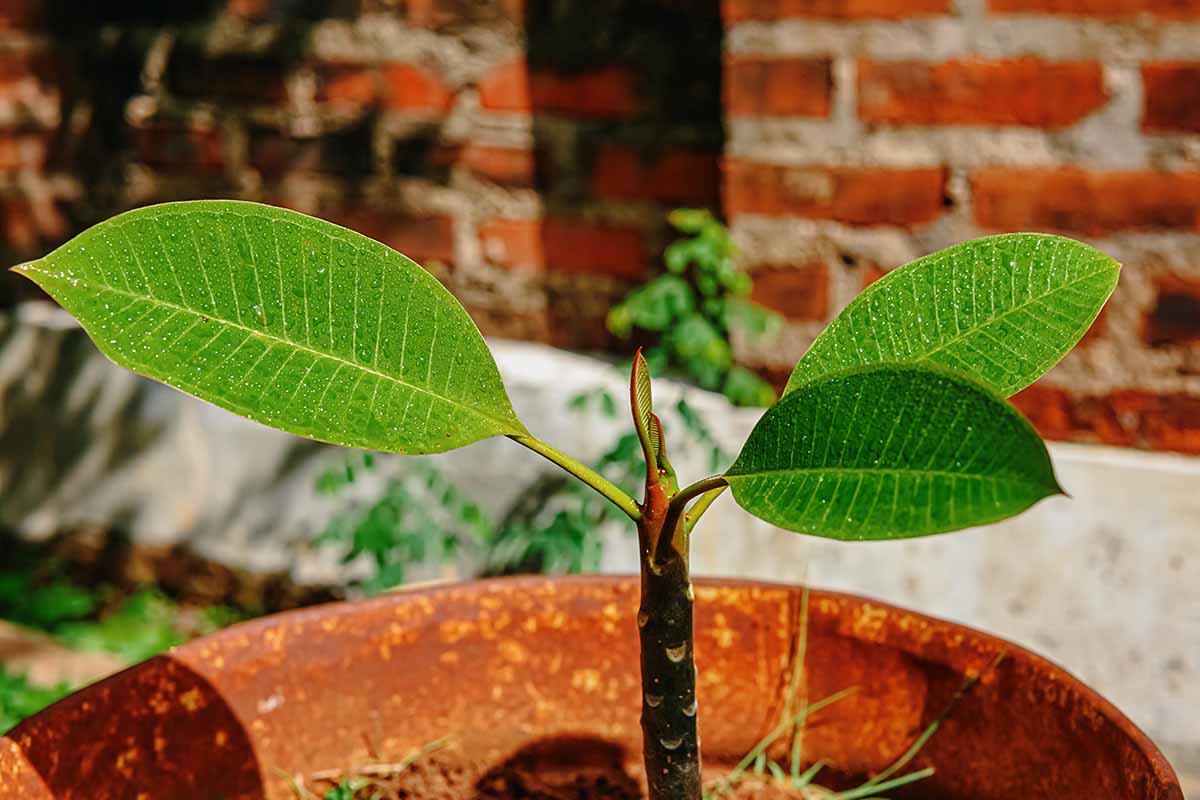
Allow them to grow with at least six hours of indirect sunlight per day and transplant them when they have three or more true leaves.
The floating technique has a few different steps.
Begin with a flat piece of styrofoam or a thin sponge. Cut slits through the material just wide enough for the seed to be inserted inside, and space them about a quarter inch apart. Don’t push the seed through beyond midway as they should not be fully submerged.
Make a small nick in each seed coat or use a piece of sandpaper to scarify each so they can more easily absorb water. Press the seeds into the slits with the papery end facing up. The root will emerge from the thicker end.
Prepare a small container of water and place it in a location that remains at or near a steady 70°F. Lay the seeded “boats” on the surface and leave them there for seven to 10 days.
After the roots have emerged and grown to about half an inch to one inch in length, place them in potting medium as previously described and move them to a warm, sunny location until they grow their true leaves.
From Cuttings
Cuttings are easy to take from frangipani, and this is also a surefire propagation method to clone parental characteristics.
The branches are thick – sometimes well over an inch in diameter. You’ll need to use sharp, clean shears to cut a branch free, and it’s best to do this in late spring or summer when the plant is actively growing.
Learn how to propagate this way in our guide to growing plumeria from cuttings. (coming soon!)
How to Grow
Members of this genus that are well suited for the home garden are easy to grow.
They need full sun for at least six hours per day, but tolerate afternoon shade in regions that regularly reaches temperatures of 90ﹾF or more.
Well-drained soil is a must, and a mix of sand, bark, and loam works best. Amend the site to include these and add one part aged manure as well, as they’re also heavy feeders.
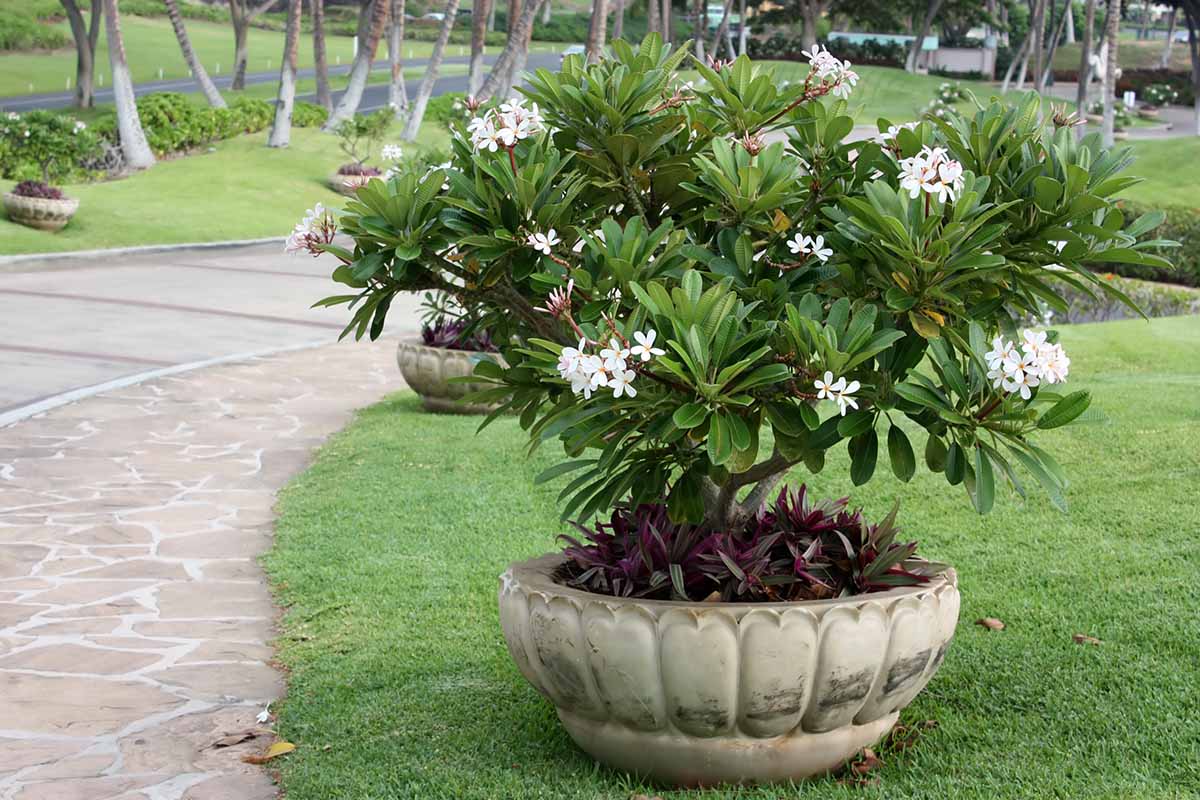
Don’t plant plumeria in clay soil or allow the roots to become waterlogged. It’s better to allow the substrate to dry out between waterings than it is to overwater.
Deep and infrequent watering is best, so watering should be done when the soil feels dry from spring through fall. It’s also important to increase watering slightly when plants are in bloom.
In subtropical regions, the leaves may begin to drop from deciduous species such as P. rubra as fall approaches and continue to drop through the season, while some species such as P. obtuse remain evergreen.
Be sure you know which type you’ve got so you won’t have to worry unnecessarily about your specimens’ reaction to the change in seasons.
There aren’t any species or cultivars that are hardy outside of Zones 9 to 11, so if you live north of these regions, plan to take some additional steps to protect yours through the winter.
Container Growing, Indoor Care, and Repotting
Container growing is also simple, as is indoor care and repotting. See our guides (coming soon!) for comprehensive information on keeping your plumeria as an indoor, container-grown plant.
A deep, wide container such as the Paloma ceramic planter, available from Terrain, allows enough space for the root ball to develop.
Fertilizing
Heavy feeders such as frangipani need fertilizer to maintain health, produce blooms, and grow normally.
Use a blossoming plant fertilizer such as Down to Earth Flower and Rose fertilizer, available from Arbico Organics in one-, five-, and 15-pound packages.
Down to Earth Flower and Rose Fertilizer
This blend has a 4-8-4 NPK ratio, which is exactly what your specimen needs to support optimum health. Apply it according to package instructions, usually once every six weeks or so, making sure to feed the first time as buds begin to set.
Don’t apply any in the two months prior to dormancy, and plan to make adjustments to accommodate the enclosed environment of a potted specimen.
Just as with any ornamental species, you may run into issues throughout the life cycle of your specimen.
Low or no blooms, bud drop, and root rot are all unfortunately common, but they can usually be addressed fairly easily when you catch signs of the telltale symptoms of each.
Growing Tips
- Place your plumeria in full sun for at least six hours per day.
- Choose a site with good drainage and amend it with bark, loam, sand, and aged manure for best results.
- Plant in a container and move the specimen indoors if you live in a region with cold winters.
- Plan to provide fertilizer regularly, as these plants are heavy feeders.
Pruning and Maintenance
Pruning is often necessary to encourage branching – otherwise, some specimens will grow thin, singular trunks that can look a bit sparse over time.
It may also be necessary to prune for size, or as a result of damage from infestation or disease from time to time.
You’ll want to make sure you know what to do ahead of time, since the last thing you want to do is cause damage by pruning too much off, or making the cuts at the wrong time, as either can prevent blooming or even shock the plant.
Learn all about pruning your frangipani in our detailed guide. (coming soon!)
Winter Care
Plumeria is tender and requires protection under about 35ﹾF. If you live in an area that has cold winters, be sure to plant yours in a container so you can move it to protection ahead of plummeting temperatures.
As I mentioned, some species will drop their leaves in preparation for dormancy and others will not.
Avoid watering during periods of winter dormancy. Some gardeners choose to remove their frangipani from its container altogether for bare root storage. If you decide to do this as well, uproot it from the soil, allow the roots to dry, and wrap them in burlap or cloth for storage.
Move the pot or wrapped tree to a cool location and allow it to remain undisturbed until spring. As temperatures begin to rise, prepare the container for replanting and gradually move it back outside.
Cultivars to Select
One of the primary issues you may run across when buying plumeria for your landscape is the huge number of unnamed hybrids that are often available for sale.
These are frequently grown from seed and listed simply as “Hawaiian plumeria,” which, of course, is technically incorrect.
I strongly recommend researching reputable growers in your area, such as plant societies, botanical gardens, and nurseries where you can actually find a specimen grown from cuttings from a known cultivar.
Unless you are happy with any of them, as long as they look and smell nice – which is totally up to you!
Bear in mind, however, that hybrids may not be the healthiest specimens as they’re produced as the result of cross-pollination rather than selective breeding. They are also frequently sterile, so you won’t be able to save your own seeds to propagate more.
If you’re not set on a specific variety, this option might be to your liking. Plants in one- or three-gallon containers are available from Fast Growing Trees. They pick the color, so whatever you get will be a surprise.
Let’s take a look at a few cultivars available today and what makes each of them so special.
Candy Stripe
For absolutely stunning blooms, ‘Candy Stripe’ can’t be beat! The three- to four-inch blossoms are primarily magenta with stripes of pink, orange, and white. While they’re not the most fragrant, they do offer a light, fruity scent.

This cultivar reaches 15 to 20 feet in height at maturity, although it may be pruned for container growing. Be sure to provide six hours or more of direct sunlight for this variety.
‘Candy Stripe’ cuttings are available from Exotica Tropicals via Amazon.
Hilo Beauty
A true showstopper – you can’t get more dramatic than ‘Hilo Beauty!’
This cultivar, also known as ‘Dakota’s Curling Red,’ exudes drama with three- to four-inch blooms in deep, blood red that can darken to nearly black. The fragrance is said to be spicier than that of many other varieties and it lasts longer as well.
The blooms have oblong, pointed petals that tend to curl back toward the stems after they open. ‘Hilo Beauty’ can grow more than 24 inches per year, so be prepared for the larger size of this specimen. It’s better suited to planting in-ground than in containers.
San Germain
Touted as the most heavily scented cultivar, ‘San Germain’ is said to smell similar to honeysuckle and jasmine. If that’s not magical enough for you, the blossoms are three inches in diameter with pointed petals and bright yellow centers.
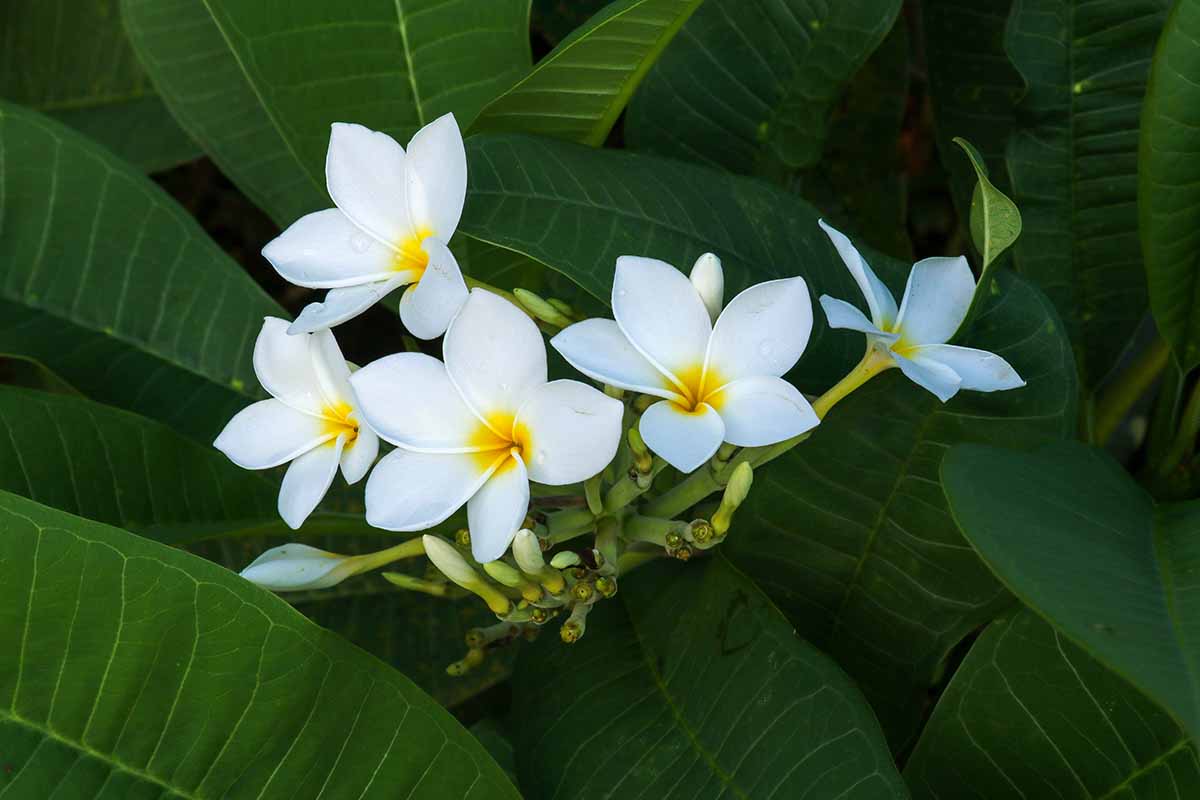
This cultivar reaches heights of 15 to 20 feet, but with significant pruning, it can be trained for container growing. If you have the space, however, it does best when planted in the ground in Zones 10 and 11.
Dwarf Pink Singapore
This compact, dwarf cultivar generally remains under about 10 feet in height, but most specimens are much smaller – usually no more than three to five feet tall.
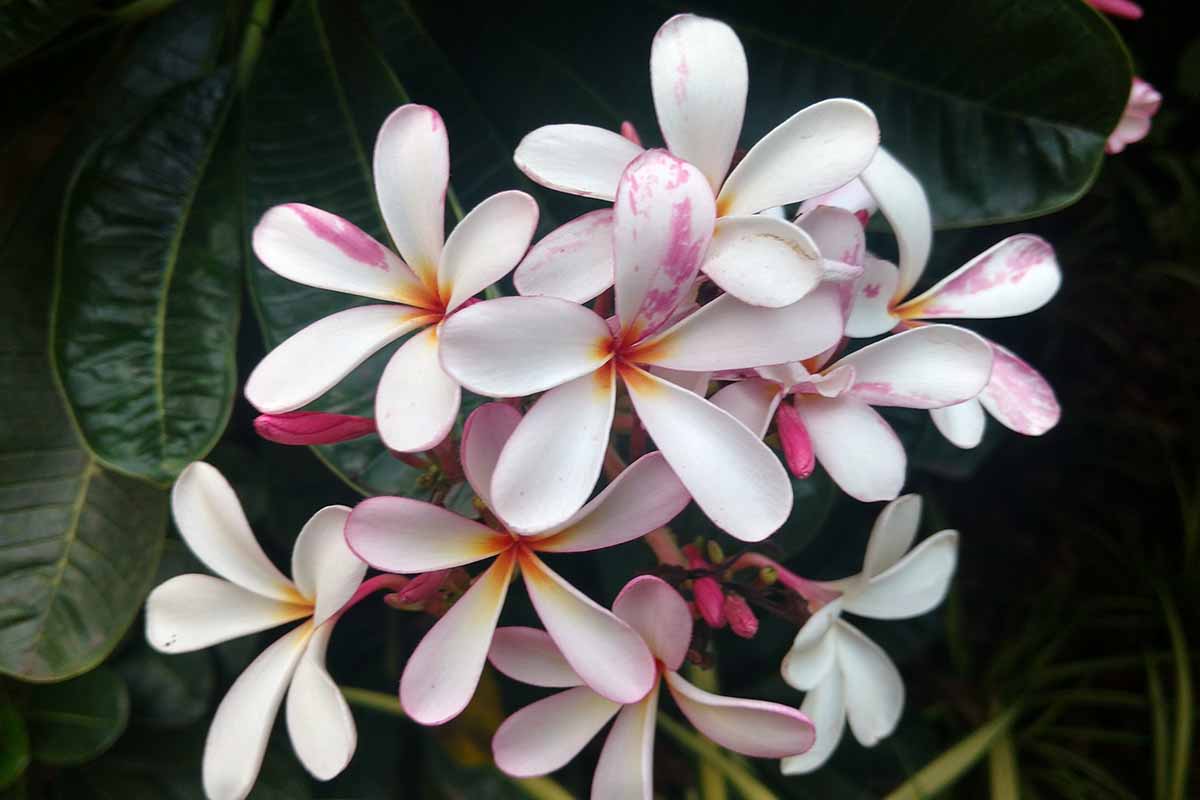
Their large, oblong, leathery leaves perfectly frame clusters of white to pale pink blossoms with magenta tubes and apricot to orange centers.
This evergreen is perfect for containers at least 18 inches deep. With a little pruning, this type can branch to create multiple trunks loaded with blossoms and foliage.
Singapore
The mesmerizing fragrance of P. obtusa ‘Singapore’ is well known as it was bred specifically for its showy white blooms with rounded petals and yellow centers that have a strong jasmine-like scent.
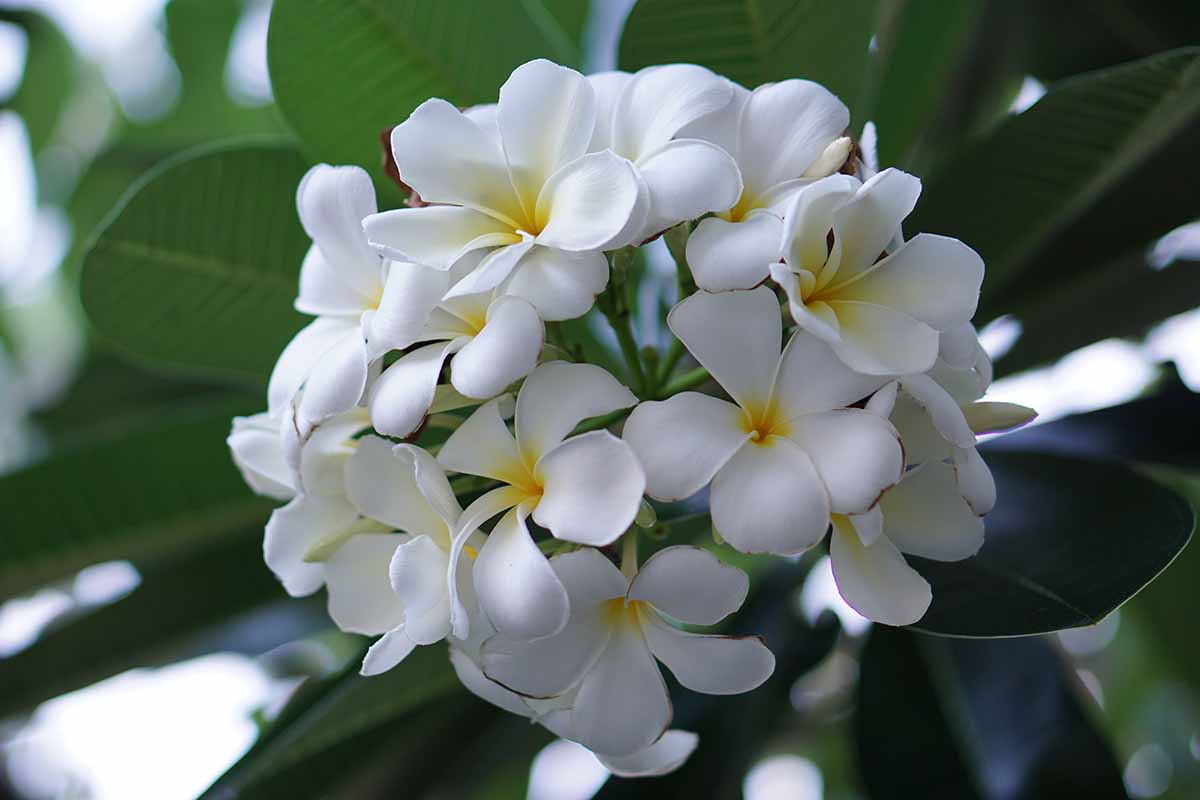
This cultivar has a more formal structure than some, growing upright to heights of up to 25 feet with sprays of foliage and clusters of blossoms appearing very uniformly throughout.
It’s also well-suited to shadier parts of the landscape, and remains evergreen in tropical regions.
Managing Pests and Disease
There are very few pests of concern and the ones that may appear are inconvenient but not generally difficult to deal with.
Because the foliage is toxic, almost all animals steer clear – even deer, although they occasionally browse the bark but rarely enough to cause damage.
Insects
Just as with many ornamentals, there are a few pests that may make an appearance on your frangipani.
Spider mites, mealybugs, and whiteflies have been seen colonizing between or under the leaves of these plants. Slugs and snails will sometimes chew the foliage as well.
Longhorn borer beetles may appear in some regions, and they’re likely the most damaging pest you’ll find associated with this genus.

You may also see the frangipani sphinx moth (Pseudosphinx tetrio) appearing in the evening, fluttering about in search of nectar. It may deposit eggs, and the larvae that hatch out grow into caterpillars of ridiculous size.
The caterpillars can defoliate plants pretty effectively, but it’s well worth sacrificing some leaves to support pollinators – and caterpillars rarely kill host plants, even if they eat a large percentage of the total foliage.
Disease
Diseases are also few and far between – great news!
Rust is the most common problem you’re likely to encounter with plumeria plants. It’s caused by fungus that is known to affect a range of plants, especially in the southern United States.
Best Uses
You can use frangipani to your garden or landscape as a feature planting, adding a luxuriously tropical appeal and luscious scent.
Group these with palms, sun-loving ferns, bananas, hibiscus, elephant ears, ginger, and bromeliads, yucca, and other tropical beauties for outstanding combinations of shape, color, and texture!
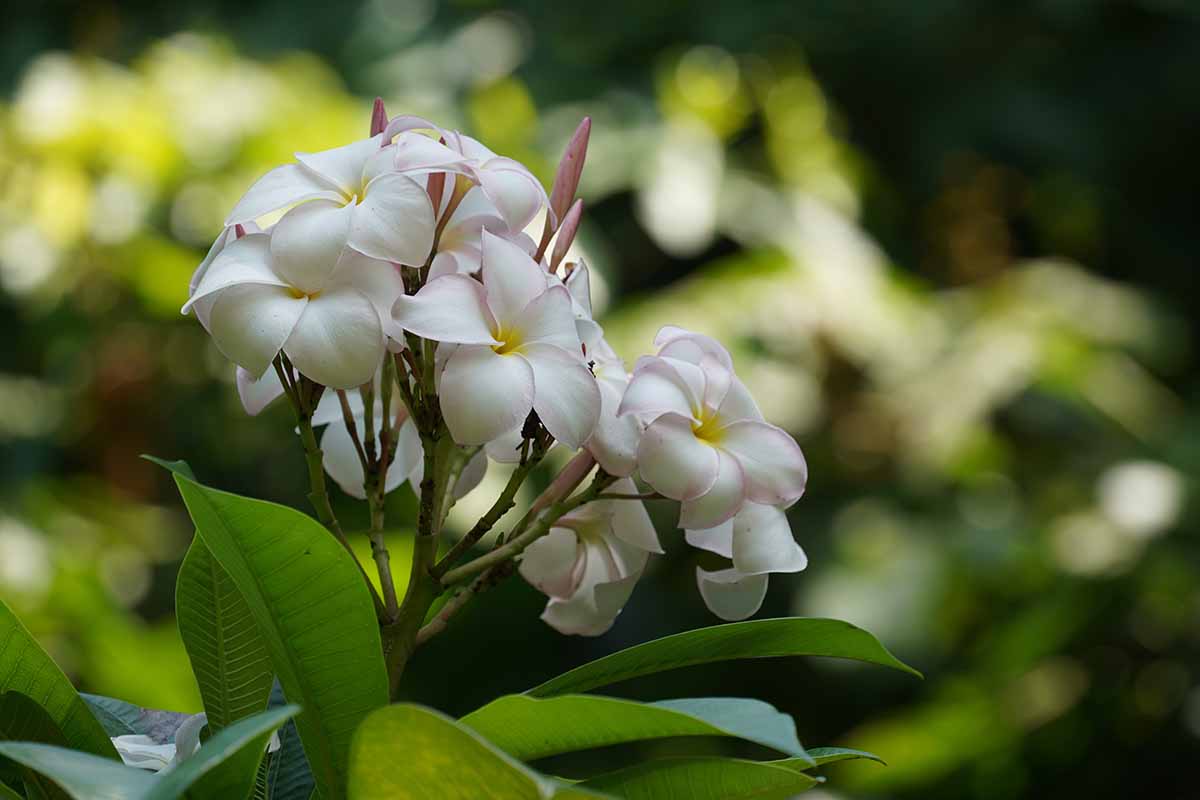
They may not be a good source of forage for pollinators, but as the centerpiece in a grouping of blooming specimens, their fragrance will draw the bees, butterflies, hummingbirds, and others in to visit the entire bed.
Several trees can be grouped poolside or near a patio where their dense canopy will create shade on hot summer days.
Potted plumeria can be added to a porch or deck where their color and scent will create a welcoming, tropical haven.
Where it’s culturally appropriate, flowers can be strung together to make fresh, gorgeous leis that can be worn or given as gifts.
And the edible flowers with their sweet, honey-like flavor can be added as a colorful pop to garnish cakes and salads.
Quick Reference Growing Guide
| Plant Type: | Woody flowering perennial | Flower / Foliage Color: | Apricot, orange, pink, red, white / yellow/green |
| Native to: | Central America and the Caribbean | Maintenance: | Low |
| Hardiness (USDA Zone): | 9-11 | Tolerance: | Drought, salt, heat, full sun |
| Bloom Time: | Spring-fall | Soil Type: | Loam, sandy loam |
| Exposure: | Full sun | Soil pH: | 5.5-6.0 |
| Spacing: | 10-20 feet | Soil Drainage: | Well-draining |
| Planting Depth: | 1/4 inch (seeds), root ball (transplants) | Companion Planting: | Bougainvillea, bromeliads, cycads, elephant ears, fountain grass |
| Growth Rate: | Moderate to fast | Uses: | Container, feature, fragrance, pollinator-attracting, shade |
| Height: | 10-30 feet | Order: | Gentianales |
| Spread: | 10-20 feet | Family: | Apocynaceae |
| Water Needs: | Moderate | Genus: | Plumeria |
| Common Pests and Diseases: | Mealybugs, spider mites, snails, slugs, whiteflies; rust | Species: | Alba, rubra, obtusa, stenopetala |
Try a Truly Tropical Tree
I feel I need to apologize to you, for you see, I’m sure I’ve led you into an obsession now that you’ve learned more about plumeria. No one could blame you – the blooms alone are a reason to be enamored of them, but those scents – they’re irresistible!
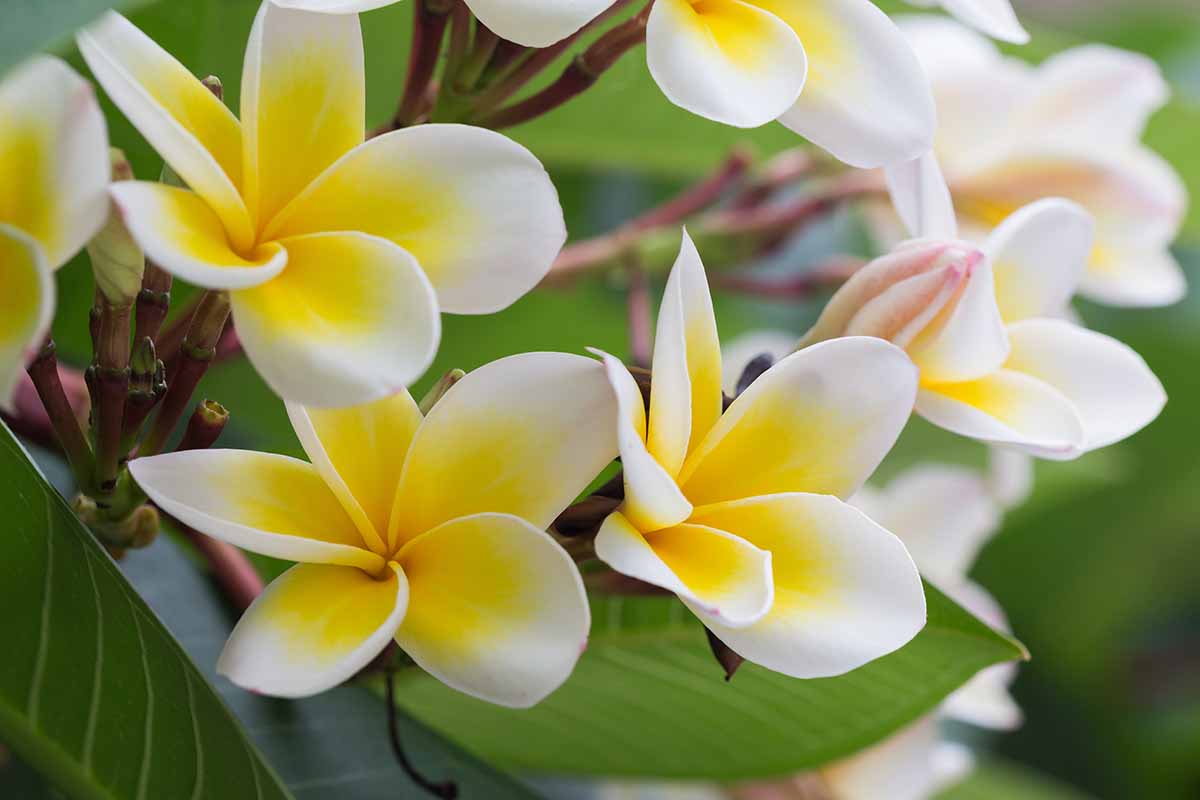
Tell me – are you planning to add a frangipani to your landscape? Will you be growing in a container? We’d love to see your selection, although it’s too bad we won’t be able to get our sniffers on it too.
If you’ve got questions, or just want to drop us a line about which type you’re growing, please leave us a comment!
And, if you’re looking for more flowering plants to consider, you might want to take a look at these guides next:
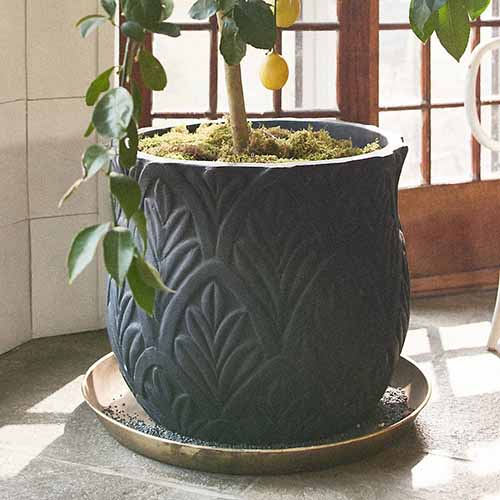
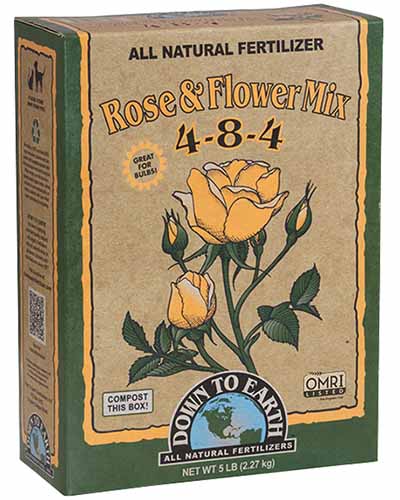
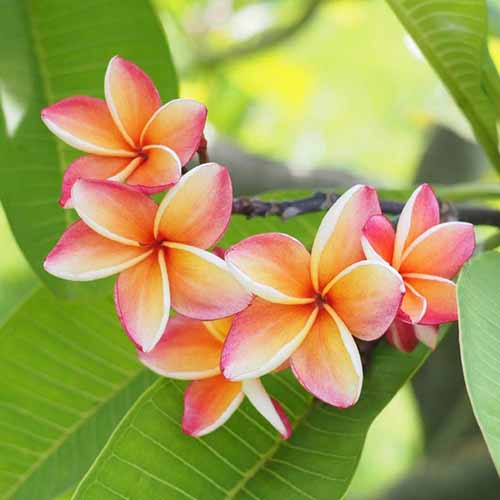



I have been looking for a Plumeria Guide Book, to learn to propagate, fertilize, pest and diseases. I love to grow them for making Leis! Aloha.
What variety is that one growing in the pot? How successful are they grown this way?
I love the look of it. Thanks for the guide ????
Plumeria can be grown in containers, as described above in our article, and it’s best to choose dwarf cultivars for this purpose.
I’m sorry but I can’t say for sure which variety this might be since the photo was not labeled with a cultivar name by the original photographer. Perhaps one of our other readers can help!
I just received a cutting from a friend as a Christmas gift. It is filling with leaves and am waiting for the blooms. I believe she said it was white but not sure.
How lovely- enjoy! Please feel free to come back and share photos here when it blooms.